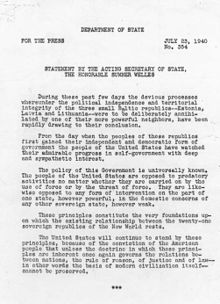
Back Declaració Welles Catalan Declaración Welles Spanish Wellesi deklaratsioon Estonian Deklarasi Welles ID Dichiarazione di Welles Italian Velso deklaracija Lithuanian Samnera Velsa deklarācija Latvian/Lettish Declaração de Welles Portuguese Декларация Уэллеса Russian Декларація Веллеса Ukrainian


The Welles Declaration was a diplomatic statement issued on July 23, 1940, by Sumner Welles, the acting US Secretary of State, condemning the June 1940 occupation by the Soviet army of the three Baltic countries – Estonia, Latvia, and Lithuania – and refusing to diplomatically recognize their subsequent annexation into the Soviet Union.[1] It was an application of the 1932 Stimson Doctrine of nonrecognition of international territorial changes that were executed by force[2] and was consistent with US President Franklin Roosevelt's attitude towards violent territorial expansion.[3]
The 1940 Soviet invasion was an implementation of its 1939 Nazi-Soviet Pact, which contained a secret protocol by which Nazi Germany and Stalinist USSR agreed to partition the independent nations between them. After the pact, the Soviets engaged in a series of ultimatums and actions ending in the annexation of the Baltic states during the summer of 1940. The area held little strategic importance to the United States, but several legations of the US State Department established had diplomatic relationships there. The United States and the United Kingdom anticipated future involvement in the war, but US non-interventionism and a foreseeable British–Soviet alliance deterred open confrontation over the Baltic states.
Welles, concerned with postwar border planning, had been authorized by Roosevelt to issue stronger public statements that gauged a move towards more intervention. Loy Henderson and other State Department officials familiar with the area kept the administration informed of developments there, and Henderson, Welles, and Roosevelt worked together to compose the declaration.
The declaration established a five-decade nonrecognition of the annexation.[4] The document had major significance for overall US policy toward Europe in the critical year of 1940.[5] The US did not engage the Soviet militarily in the region, but the declaration enabled the Baltic states to maintain independent diplomatic missions, and Executive Order 8484 protected Baltic financial assets. Its essence was supported by all subsequent US presidents and congressional resolutions.
The Baltic states re-established their independence in 1990 and 91.
- ^ Hiden, et al, p. 3
- ^ Cite error: The named reference
Hiden39was invoked but never defined (see the help page). - ^ Hiden, et al, p. 40
- ^ Made, Vahur. "Foreign policy statements of Estonian diplomatic missions during the Cold War: establishing the Estonian pro-US discourse". Estonian School of Diplomacy. Archived from the original on 2008-10-17. Retrieved 2009-05-02.
- ^ Hiden, et al, pp. 33–34
© MMXXIII Rich X Search. We shall prevail. All rights reserved. Rich X Search